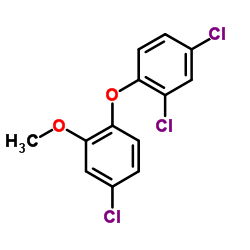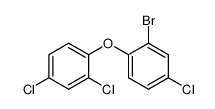4640-01-1
| 中文名 | 三氯生甲酯 |
|---|---|
| 英文名 | Triclosan Methyl Ether |
| 中文别名 |
三氯生甲基
2,4,4'-三氯-2'-羟基二苯醚甲酯 |
| 英文别名 |
Benzene, 4-chloro-1-(2,4-dichlorophenoxy)-2-methoxy-
Benzene, 2,4-dichloro-1-(4-chloro-2-methoxyphenoxy)- 2,4-Dichloro-1-(4-chloro-2-methoxyphenoxy)benzene |
| 描述 | Triclosan-methyl 是 Triclosan 的转化产物。Triclosan 是个人护理产品(如牙膏,洗发水和肥皂)中的杀菌剂。Triclosan 还是多种洗涤剂和化妆品中的稳定剂。 |
|---|---|
| 相关类别 | |
| 参考文献 |
| 密度 | 1.4±0.1 g/cm3 |
|---|---|
| 沸点 | 358.7±42.0 °C at 760 mmHg |
| 分子式 | C13H9Cl3O2 |
| 分子量 | 303.568 |
| 闪点 | 128.5±28.0 °C |
| 精确质量 | 301.966827 |
| PSA | 18.46000 |
| LogP | 4.74 |
| 外观性状 | 无色糖浆 |
| 蒸汽压 | 0.0±0.8 mmHg at 25°C |
| 折射率 | 1.589 |
| 储存条件 | Refrigerator |
|
Section1. IDENTIFICATION OF THE SUBSTANCE/MIXTURE Product identifiers Product name: Triclosan-methyl CAS-No.: 4640-01-1 Relevant identified uses of the substance or mixture and uses advised against Identified uses: Laboratory chemicals, Manufacture of substances Section2. HAZARDS IDENTIFICATION Classification of the substance or mixture Classification according to Regulation (EC) No 1272/2008 [EU-GHS/CLP] Acute aquatic toxicity (Category 1) Chronic aquatic toxicity (Category 1) Classification according to EU Directives 67/548/EEC or 1999/45/EC Very toxic to aquatic organisms, may cause long-term adverse effects in the aquatic environment. Label elements Labelling according Regulation (EC) No 1272/2008 [CLP] Pictogram Signal wordWarning Hazard statement(s) H410Very toxic to aquatic life with long lasting effects. Precautionary statement(s) P273Avoid release to the environment. P501Dispose of contents/ container to an approved waste disposal plant. Supplemental Hazardnone Statements According to European Directive 67/548/EEC as amended. Hazard symbol(s) R-phrase(s) R50/53Very toxic to aquatic organisms, may cause long-term adverse effects in the aquatic environment. S-phrase(s) S60This material and its container must be disposed of as hazardous waste. S61Avoid release to the environment. Refer to special instructions/ Safety data sheets. Caution - substance not yet tested completely. Other hazards - none Section3. COMPOSITION/INFORMATION ON INGREDIENTS Substances Synonyms: Methyl triclosan 5-Chloro-2-(2,4-dichlorophenoxy)anisole 2,4,4′-Trichloro-2′-methoxydiphenyl ether Formula: C13H9Cl3O2 Molecular Weight: 303,57 g/mol ComponentConcentration 4-Chloro-1-(2,4-dichlorophenoxy)-2-methoxybenzene CAS-No.4640-01-1- Section4. FIRST AID MEASURES Description of first aid measures General advice Consult a physician. Show this safety data sheet to the doctor in attendance. If inhaled If breathed in, move person into fresh air. If not breathing, give artificial respiration. Consult a physician. In case of skin contact Wash off with soap and plenty of water. Consult a physician. In case of eye contact Flush eyes with water as a precaution. If swallowed Never give anything by mouth to an unconscious person. Rinse mouth with water. Consult a physician. Most important symptoms and effects, both acute and delayed To the best of our knowledge, the chemical, physical, and toxicological properties have not been thoroughly investigated. Indication of any immediate medical attention and special treatment needed no data available Section5. FIREFIGHTING MEASURES Extinguishing media Suitable extinguishing media Use water spray, alcohol-resistant foam, dry chemical or carbon dioxide. Special hazards arising from the substance or mixture Carbon oxides, Hydrogen chloride gas Advice for firefighters Wear self contained breathing apparatus for fire fighting if necessary. Further information no data available Section6. ACCIDENTAL RELEASE MEASURES Personal precautions, protective equipment and emergency procedures Use personal protective equipment. Avoid breathing vapors, mist or gas. Ensure adequate ventilation. Evacuate personnel to safe areas. Environmental precautions Prevent further leakage or spillage if safe to do so. Do not let product enter drains. Discharge into the environment must be avoided. Methods and materials for containment and cleaning up Soak up with inert absorbent material and dispose of as hazardous waste. Keep in suitable, closed containers for disposal. Reference to other sections For disposal see section 13. Section7. HANDLING AND STORAGE Precautions for safe handling Normal measures for preventive fire protection. Conditions for safe storage, including any incompatibilities Store in cool place. Keep container tightly closed in a dry and well-ventilated place. Containers which are opened must be carefully resealed and kept upright to prevent leakage. Specific end use(s) no data available Section8. EXPOSURE CONTROLS/PERSONAL PROTECTION Control parameters Components with workplace control parameters Exposure controls Appropriate engineering controls Handle in accordance with good industrial hygiene and safety practice. Wash hands before breaks and at the end of workday. Personal protective equipment Eye/face protection Use equipment for eye protection tested and approved under appropriate government standards such as NIOSH (US) or EN 166(EU). Skin protection Handle with gloves. Gloves must be inspected prior to use. Use proper glove removal technique (without touching glove's outer surface) to avoid skin contact with this product. Dispose of contaminated gloves after use in accordance with applicable laws and good laboratory practices. Wash and dry hands. The selected protective gloves have to satisfy the specifications of EU Directive 89/686/EEC and the standard EN 374 derived from it. Body Protection impervious clothing, The type of protective equipment must be selected according to the concentration and amount of the dangerous substance at the specific workplace. Respiratory protection Where risk assessment shows air-purifying respirators are appropriate use a full-face respirator with multi-purpose combination (US) or type ABEK (EN 14387) respirator cartridges as a backup to engineering controls. If the respirator is the sole means of protection, use a full-face supplied air respirator. Use respirators and components tested and approved under appropriate government standards such as NIOSH (US) or CEN (EU). Section9. PHYSICAL AND CHEMICAL PROPERTIES Information on basic physical and chemical properties a) AppearanceForm: liquid b) Odourno data available c) Odour Thresholdno data available d) pHno data available e) Melting point/freezingno data available point f) Initial boiling point and no data available boiling range g) Flash pointno data available h) Evaporation rateno data available i) Flammability (solid, gas) no data available j) Upper/lowerno data available flammability or explosive limits k) Vapour pressureno data available l) Vapour densityno data available m) Relative densityno data available n) Water solubilityno data available o) Partition coefficient: n- log Pow: 5,269 octanol/water p) Auto-ignitionno data available temperature q) Decompositionno data available temperature r) Viscosityno data available s) Explosive propertiesno data available t) Oxidizing propertiesno data available Other safety information no data available Section10. STABILITY AND REACTIVITY Reactivity no data available Chemical stability no data available Possibility of hazardous reactions no data available Conditions to avoid no data available Incompatible materials Strong oxidizing agents Hazardous decomposition products Other decomposition products - no data available Section11. TOXICOLOGICAL INFORMATION Information on toxicological effects Acute toxicity no data available Skin corrosion/irritation no data available Serious eye damage/eye irritation no data available Respiratory or skin sensitization Prolonged or repeated exposure may cause allergic reactions in certain sensitive individuals. Germ cell mutagenicity no data available Carcinogenicity IARC:No component of this product present at levels greater than or equal to 0.1% is identified as probable, possible or confirmed human carcinogen by IARC. Reproductive toxicity no data available Specific target organ toxicity - single exposure no data available Specific target organ toxicity - repeated exposure no data available Aspiration hazard no data available Potential health effects InhalationMay be harmful if inhaled. May cause respiratory tract irritation. IngestionMay be harmful if swallowed. SkinMay be harmful if absorbed through skin. May cause skin irritation. EyesMay cause eye irritation. Signs and Symptoms of Exposure To the best of our knowledge, the chemical, physical, and toxicological properties have not been thoroughly investigated. Additional Information RTECS: Not available Section12. ECOLOGICAL INFORMATION Toxicity no data available Persistence and degradability no data available Bioaccumulative potential no data available Mobility in soil no data available Results of PBT and vPvB assessment no data available Other adverse effects Very toxic to aquatic life. Section13. DISPOSAL CONSIDERATIONS Waste treatment methods Product Offer surplus and non-recyclable solutions to a licensed disposal company. Contact a licensed professional waste disposal service to dispose of this material. Contaminated packaging Dispose of as unused product. Section14. TRANSPORT INFORMATION UN number ADR/RID: 3082IMDG: 3082IATA: 3082 UN proper shipping name ADR/RID: ENVIRONMENTALLY HAZARDOUS SUBSTANCE, LIQUID, N.O.S. (4-Chloro-1-(2,4- dichlorophenoxy)-2-methoxybenzene) IMDG: ENVIRONMENTALLY HAZARDOUS SUBSTANCE, LIQUID, N.O.S. (4-Chloro-1-(2,4- dichlorophenoxy)-2-methoxybenzene) IATA:Environmentally hazardous substance, liquid, n.o.s. (4-Chloro-1-(2,4-dichlorophenoxy)-2- methoxybenzene) Transport hazard class(es) ADR/RID: 9IMDG: 9IATA: 9 Packaging group ADR/RID: IIIIMDG: IIIIATA: III Environmental hazards ADR/RID: yesIMDG Marine Pollutant: yesIATA: yes Special precautions for user Further information EHS-Mark required (ADR 2.2.9.1.10, IMDG code 2.10.3) for single packagings and combination packagings containing inner packagings with Dangerous Goods > 5L for liquids or > 5kg for solids. Section15. REGULATORY INFORMATION This safety datasheet complies with the requirements of Regulation (EC) No. 1907/2006. Safety, health and environmental regulations/legislation specific for the substance or mixture no data available Chemical Safety Assessment no data available Section16. OTHER INFORMATION Further information Copyright 2012 Co. LLC. License granted to make unlimited paper copies for internal use only. The above information is believed to be correct but does not purport to be all inclusive and shall be used only as a guide. The information in this document is based on the present state of our knowledge and is applicable to the product with regard to appropriate safety precautions. It does not represent any guarantee of the properties of the product. Corporation and its Affiliates shall not be held liable for any damage resulting from handling or from contact with the above product. See and/or the reverse side of invoice or packing slip for additional terms and conditions of sale. |
| 符号 |

GHS09 |
|---|---|
| 信号词 | Warning |
| 危害声明 | H410 |
| 警示性声明 | P273-P501 |
| 个人防护装备 | Eyeshields;Gloves;half-mask respirator (US);multi-purpose combination respirator cartridge (US) |
| 危害码 (欧洲) | N |
| 风险声明 (欧洲) | 50/53 |
| 安全声明 (欧洲) | 60-61 |
| 危险品运输编码 | UN 3082 9/PG 3 |
| 海关编码 | 2909309090 |
|
~% 
4640-01-1 |
| 文献:US6133483 A1, ; |
|
~% 
4640-01-1 |
| 文献:Organic Mass Spectrometry, , vol. 20, # 2 p. 122 - 133 |
|
~% 
4640-01-1 |
| 文献:Bioorganic and Medicinal Chemistry Letters, , vol. 23, # 4 p. 1022 - 1025 |
|
~% 
4640-01-1 |
| 文献:Biomedical Mass Spectrometry, , vol. 5, # 3 p. 224 - 231 |
| 海关编码 | 2909309090 |
|---|---|
| 中文概述 | 2909309090 其他芳香醚及其卤化衍生物、磺化、硝化衍生物(包括亚硝化衍生物)。监管条件:无。增值税率:17.0%。退税率:9.0%。最惠国关税:5.5%。普通关税:30.0% |
| 申报要素 | 品名, 成分含量, 用途 |
| Summary | 2909309090 other aromatic ethers and their halogenated, sulphonated, nitrated or nitrosated derivatives VAT:17.0% Tax rebate rate:9.0% Supervision conditions:none MFN tariff:5.5% General tariff:30.0% |





